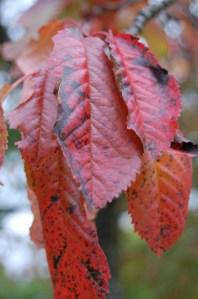
Prunus avium autumn leaf (08/10/2011, Horní Bečva, Czech)
Position: Full sun
Flowering period: Spring
Soil: Well Drained
Eventual Height: 12m
Eventual Spread: 8m
Hardiness: USDA Zones 5a-9b
Family: Rosaceae
Prunus avium, is a medium sized, native, deciduous tree with a bushy habit and neat rounded crown. It’s foliage is green in Spring and Summer, becoming orange and red in Autumn. The leaves are alternate, simple ovoid-acute, 7-14cm long and 4-7cm broad, glabrous matt or sub-shiny green above, variably finely downy beneath, with a serrated margin and an acuminate tip. The leaves have a green to reddish petiole 3cm long. The bark of the tree is smooth brown, bearing the distinctive Cherry rings around the trunk, becoming more fissured on older trees. The trunk of this tree may achieve a diameter of 1.5m. A profusion of hermaphrodite flowers are produced in early spring, at the same time as the new leaves. They are borne in corymbs of two to six, with 5 pure white petals, yellowish stamens and a superior ovary. The fruit is a drupe 1-2 cm in diameter, becoming bright red to dark purple when mature in mid-summer and contains a hard shelled stone which contains the seed. The trunk is straight in appearance.
Prunus avium, commonly known as the Wild Cherry or Sweet cherry, is native to Europe, west Turkey, northwest Africa and western Asia, including the UK. There is also a small disjunct population in the western Himalayas. The early history of its classification is somewhat confused. In the first edition of Species Plantarum, published 1753, Linnaeus treated it only as a variety. It was then changed from a variety, to the Species Prunus avium in the second edition of his Flora Suecica in 1755. P. avium has long been cultivated for the production of the edible Cherry; 800BC in Asia Minor. All parts of the tree are slightly toxic apart from the ripe fruit.
The etymological root of the binomial name for Prunus is the classical Latin name of the plum tree. Avium is derived from the Latin avium meaning ‘wild or wilderness’. There are numerous references to avium beeing derived from the Latin avis meaning ‘bird’ but I believe this to be incorrect. I would welcome reader feedback on this topic.
Prunus avium (08/10/2011, Horní Bečva, Czech)
The landscape architect may find Prunus avium useful as an attractive flowering native parkland tree. Care should be taken when locating this tree as some of it’s roots are shallow and may deform tarmac or be hit by lawn mowers, which will encourage this tree to sucker. P. avium is also useful in a wildlife garden or community allotment due to it’s native provenance and edible fruit.
Ecologically the fruit of this tree are eaten by numerous birds and mammals; which disperse it’s seed. The leaves provide food for some animals including species of Lepidoptera.
This plant has been awarded the RHS award of garden merit 1993.
Prunus avium prefers well drained fertile soils. It will tolerate most soils but has a preference for neutral to lime rich soils.
Maintenance: This plant requires little maintenance. Pruning should be carried out in summer to avoid silver leaf.

